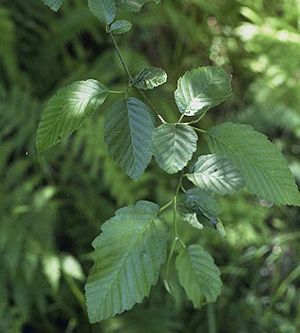Red alder
| Red alder | ||||||||||||
|---|---|---|---|---|---|---|---|---|---|---|---|---|

Red alder leaves arranged alternately on the branches. |
||||||||||||
| Systematics | ||||||||||||
|
||||||||||||
| Scientific name | ||||||||||||
| Alnus rubra | ||||||||||||
| Bong. |
The red alder or Oregon alder ( Alnus rubra ) native to western North America is the world's largest species of alder ( Alnus ) from the birch family (Betulaceae). It grows in an approximately 200 km wide strip along the Pacific coast, which extends from southeastern Alaska to California . At the height of the US state of Washington , it can also be found 600 km inland in Idaho .
description
The red alder is a deciduous deciduous tree that reaches heights of 20 to 35 m. The currently tallest tree with 32 m is in Clatsop County , Oregon ( USA ). Its name is derived from the rusty, light red color of its wood when it has been freshly felled. The bark is gray, smooth and covered with small round cork warts .
The alternate leaves are ovate, 7 to 15 cm long, have rough sawn edges and are clearly pointed. They are bent downwards. In this characteristic they differ from the leaves of all other alder species. The leaves of the red alder turn yellow in autumn before they fall off.
The red alder blooms in February and March, well before the leaves shoot. It is single sexed ( monoecious ). The male inflorescences are 10 to 15 cm long, drooping, reddish catkins . The female kittens are erect and develop into 2 to 3 cm long, woody cones . The pollination is carried on the wind. The seeds are also released by the wind in autumn and winter.
The number of chromosomes is 2n = 28.
distribution
The red alder grows in southern Alaska , western British Columbia and the northwest coastal mountains of the USA on cool and moist slopes. Here it forms the stand together with the Douglas fir ( Pseudotsuga menziesii subsp. Menziesii ), the West American hemlock ( Tsuga heterophylla ), the coastal fir ( Abies grandis ), the giant arborvitae ( Thuja plicata ) and the Sitka spruce ( Picea sitchensis ) .

In the interior and on the southern border of its range, in California, it grows mainly on rivers and in swamp forests. Here it is often found together with willows , the silky dogwood ( Cornus stolonifera ), the Oregon ash ( Fraxinus latifolia ) and the Oregon maple ( Acer macrophyllum ).
The white alder ( Alnus rhombifolia ) grows southeast of its distribution area . It is closely related to the red alder, but has no bent leaves. In the high mountains, instead of the red alder, the smaller green alder ( Alnus viridis subsp. Sinuata ) grows , in the east of the cascade chain the gray alder ( Alnus incana subsp. Tenuifolia ) grows .
The red alder is a typical pioneer tree. It quickly colonizes open areas created by fire or deforestation and prepares the growth of the above-mentioned conifers by improving the soil.
The red alder produces an extremely large number of seeds, which, however, can only germinate in open mineral soil. In the first year, several hundred thousand or even several million seedlings per hectare can be found on cleared areas (Zavitkovski & Stevens 1972).
With the help of the Frankia alni bacterium, the red alder is able to bind nitrogen from the air. This enables it to grow on low-nitrogen soils.
Cultivation and use
A red-yellow dye can be obtained by boiling the bark. It was used by the indigenous peoples of North and South America to dye fishing nets so that they were less visible in the water.
The red alder is an important tree for forestry . Their rapid growth makes them particularly suitable for colonizing fallow land . Their numerous seeds help to enrich the humus with nitrogen when they are decomposed. It is grown alternately with conifers in order to prevent the spread of the Phellinus weirii fungus , which particularly affects the Douglas firs and causes severe damage.
The logging industry used to regard red alder as a " weed " and sprayed herbicides over large red alder forests in Oregon and Washington . The increasing value of wood, combined with a better understanding of the positive effects that the red alder has on other trees, largely resulted in the end of this practice.
The wood is not durable for outdoor use. But it is used for furniture and other carpentry work. It used to be considered very low in value, but has now become a fairly important hardwood in the western United States. It's white, pink, or light brown, it's easy to edit, stick well, and it's permanent.
Red alders are generally not planted as ornamental trees.
literature
- Zavitkovski, J. & Stevens, RD (1972). Primary productivity of red alder ecosystems. Ecology 53 (2): 235-242.
- Flora of North America: Alnus rubra
Web links
- Plants of British Columbia: Alnus rubra
- Jepson Flora: Alnus rubra
- USDA Plants Profile: Alnus rubra

